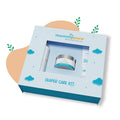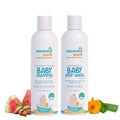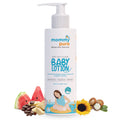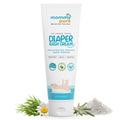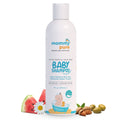Food hygiene in babies

It is a beautiful feeling when your cupcake grows big enough and is ready to have some soft food other than milk. We are sure you are just too happy planning the menu and making a list of everything that your baby can have on the platter. We are also glad to be a part of your baby's transition to solids. And this time we have come up with something which after reading you would definitely agree on its importance and the necessity for implementation. Well, it's “Food Hygiene” that we at Mommypure want to talk about.
Food hygiene should be a foremost concern when it comes to your baby. You take utmost care of your bubbles. Often food safety may unintentionally get ignored or neglected. Do you know that poor hygiene can end up in food contamination and result in serious health consequences? Now this should be an absolute NO!
Growing is an important phase of cupcake’s life. Good Nutrition is a way towards healthy growth. What is food hygiene all about and why it is so important? And how to ensure your little one's food hygiene?
In simple words, Food Hygiene can be defined as the measures that are essential to ensure the food is safe for your baby's consumption. Your tiny tot's immune system is still in the development stage and food contamination can occur due to various reasons and that too easily.
All this sounds so disturbing! But there is definitely a way out and this can be tackled easily. In the health care sector, there are certain aspects that are followed when it comes to food hygiene and safe handling. Commonly known as 4 C’s these too can be applied in your honey pies cooking routine. These are cleaning cooking, cross-contamination, and chilling which tells you the simple rules that need to be applied to all those who are involved in your baby's food preparation and all the chores related to cooking.
So let us talk about it…
Cleaning:

Pathogens and germs are everywhere. The best way to control their growth and spread is through proper cleaning and sanitization. It involves the hygiene of the cooking areas, utensils, food items, and personal cleanliness.
- Wash your hands thoroughly before and after handling/cleaning/cooking/serving/storing food. This practice reduces the chances of bacteria contaminating the food through your hands.
- The hair should be well tied or you can use a hair net
- Ensure that sneezing/coughing/chewing/eating protocols are followed while cooking food
- Your cooking areas, countertops, tables, kitchen sink, cutting boards, etc. where food items cleaning and the cooking process takes place should be disinfected with good and safe germicidal wash
- Other areas of cleaning include proper waste management which often gets undermanaged. The disposal of food waste should be in closed bins. Do not touch the bin with your hands. Use a lid that can open up with the help of your foot. If at all you happen to touch the garbage bag of the bin wash your hands immediately. Make a routine to wash those bins whenever they seem to be dirty/stinky
- The cooking area should be free from pets and do timely pest control to avoid insects, rodents, flies, and roaches
- Always cover the food containers properly
- The baby food utensils, spoons, bowls, sippers, feeding mugs, straws, and feeding chair top/table, bib, mat, and everything that your baby owns are to be thoroughly washed before every use
- The tiny bees may also want to eat the finger foods, great! But wash their hands before and after their munching task
- The kitchen towels, dishcloths, sponges, scrubs are the medium for bacteria and germs to thrive and spoil food. Soak them in hot soapy water for some time and wash them later. Change them regularly and use some disinfectant liquid to sterile them
- Since it’s a cleaning job the water should be clean as well. Use filtered water or RO water for all cooking purposes
- Keep your little one always away from these areas
Cooking:

- Most of the items need to be cooked before they can be served to your apple pie. Follow the cooking protocols well in the cooking schedule, especially the raw items such as underground roots, meat, poultry, eggs, seafood, etc.
- Try to avoid giving raw food such as raw eggs, cakes cream, mayonnaise, uncooked mixtures, and alike to your honeybees
- Each item needs a different cooking temperature
- Prefer making fresh meals every time
- Do thorough cooking as over cooking may destroy the nutrients and any uncooked food may end up making the baby sick
- If you are into packaged or ready-to-eat food items, then make sure you read and understand the instructions carefully. When you reheat the cooked food, it should be piping hot
- Don’t forget to check the temperature every time before serving. Feed your tiny tots once the food has come to consumable temperature
- Avoid keeping the cooked food outside for long as it can likely cause germs multiplication
- Certain food can be eaten directly but after thorough washing and scrubbing. These include salads, carrots, fruits, etc.
- Some food has to be heated/treated before consumption such as milk. Read the labels of the packaged food and check if the items are raw or processed.
Cross-Contamination:
This is defined as the spoiling of food due to unclean utensils, handling, and contact with uncooked food items. Unknowingly this serves as a pathway for germs to enter the food and end in its contamination thereby resulting in food poisoning. Remember these germs are always ready to invade at the first possible chance of entry. Set your sanitization skills to always safeguard your bumble bee’s food stock.- Always maintain a good distance between the raw and cooked food
- Besides food, there could be other food items like eggs, meat, veggies, and underground roots that you may need to refrigerate. Keep them in separate compartments/containers to avoid any contamination from each other
- Also, discard the food that has been left over. Don’t keep it to be fed later. The spoon has saliva secretion that can facilitate bacterial growth
- When you buy veggies, fruits or salads look for damaged or broken, or spoiled areas. They are the gateway for the germs to pass in. Tend to buy the ones that are complete in their skin and attached well to the stalk
- Once your cooking is done, keep all the utensils that you have used for thorough washing. The surfaces, tabletops should also be sanitized well to avoid any bugs from flourishing
- A 100 % germ-free environment anywhere is not possible. But with regular cleaning protocols at least you can eradicate maximum bacteria and other germs and prevent their colonization.
Chilling:

- There could be situations when you cook plenty in order to keep food ready or handy for serving on time. So, this needs to be stored in the freezer or fridge
- First allow the food to cool down after cooking, and make small portions for ideal pick up and cooling to the core.
- Keeping all of it in one container will make it difficult to get the required quantity and reheat.
- Temperature fluctuations can favour germs growth easily.
- Also, make sure the container for storing is sterile enough.
Food hygiene practices are crucial for their safe consumption and optimum availability of nutrition. All those involved in your baby’s food-related chores need to be well trained on the food hygiene protocols.
It can be quite tasking following all these guidelines but nothing is more important than your baby’s well-being. This will save your visit to the doctor, painful illness period for your baby, and unnecessary expenses on the medications. The best benefit it can reap out is the healthy growth of your pumpkin butter and plentiful happy hours together!
Have a safe meal time with your cupcakes and don’t forget to have some hygienic fun too.


